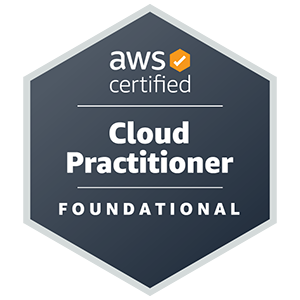We recommend that you prepare for the AWS Certified Cloud Practitioner (CLF-C01) exam with the Amazon CLF-C01 dumps updated CLF-C01 preparation resources.
Pass4itSure CLF-C01 dumps online exam preparation resources: https://www.pass4itsure.com/aws-certified-cloud-practitioner.html Have it, you will have a large number of valid CLF-C01 exam study materials, and you can easily pass the Amazon CLF-C01 exam.
Can you summarize the exam? AWS Certified Cloud Practitioner (CLF-C01)
The AWS Certified Cloud Practitioner (CLF-C01) exam requires you to answer 65 questions (Multiple-choice or multiple-choice questions) in 90 minutes and score 700 to pass. The perfect score is 1000.
Take and pass the AWS Certified Cloud Practitioner exam (Amazon CLF-C01) to earn this certification.
What are the effective learning resources for the CLF-C01 exam, and can you summarize them?
- AWS Certified Cloud Practitioner Exam Guide
- AWS Certified Cloud Practitioner Sample Questions
- AWS Certified Cloud Practitioner Official Practice Question Set
- Exam Prep: AWS Certified Cloud Practitioner
- Exam Readiness: AWS Certified Cloud Practitioner
- Pass4itSure CLF-C01 dumps
- AWS Skill Builder
- AWS Cloud Practitioner Essentials
- AWS Power Hour: Cloud Practitioner
- Overview of Amazon Web Services
- How AWS Pricing Works
- Compare AWS Support Plans
Want an easy way to pass the AWS Certified Cloud Practitioner (CLF-C01) exam?
First, good CLF-C01 exam preparation resources are needed to help you prepare effectively.
Here, the Pass4itSure CLF-C01 dumps are recommended. It provides you with real and effective CLF-C01 exam preparation resources for you to study.
Secondly, practice is also important.
You need to practice the CLF-C01 exam questions regularly to improve your exam skills.
By doing so, the CLF-C01 exam is easy to pass.
CLF-C01 Free Dumps (CLF-C01 Exam Questions Free)
Q1. According to the AWS shared responsibility model, what is the sole responsibility of AWS?
A. Application Security
B. Edge location management
C. Patch management
D. Client-side data
Correct Answer: B
Client-side data and application security is the sole responsibility of the customer. Patch management is a shared responsibility. That leaves us with edge location management and since this is out of the control of the customer, AWS is the one responsible for it.
Reference: https://aws.amazon.com/compliance/shared-responsibility-model/
Q2. A company plans to store sensitive data in an Amazon S3 bucket. Which task is the responsibility of AWS?
A. Activate encryption at rest for the data.
B. Provide security for the physical infrastructure.
C. Train the company\\’s employees about cloud security.
D. Remove personally identifiable information (PII) from the data.
Correct Answer: A
Amazon S3 can often house sensitive and confidential information. To help secure your data within Amazon S3, you should be using AWS Key Management Service (AWS KMS) with server-side encryption at rest for Amazon S3. It is also important that you secure the S3 buckets so that you only allow access to the developers and users who require that access.
Q3. Which service enables customers to audit API calls in their AWS accounts?
A. AWS CloudTrail
B. AWS Trusted Advisor
C. Amazon Inspector
D. AWS X-Ray
Correct Answer: A
Reference: https://aws.amazon.com/cloudtrail/
Q4. Which AWS services provide a way to extend an on-premises architecture to the AWS Cloud? (Choose two.)
A. Amazon EBS
B. AWS Direct Connect
C. Amazon CloudFront
D. AWS Storage Gateway
E. Amazon Connect
Correct Answer: BD
Reference: https://aws.amazon.com/hybrid/
Q5. A company has defined the AWS resources that it needs for a new application. The company needs to estimate the costs of running the application on AWS. What should the company do to meet this requirement?
A. Take advantage of AWS on-demand pricing.
B. Use the AWS Pricing Calculator to generate an approximate dollar amount.
C. Use Amazon QuickSight to analyze current on-premises spending.
D. Use Amazon AppStream 2.0 for real-time pricing analytics.
Correct Answer: B
Reference: https://aws.amazon.com/premiumsupport/knowledge-center/estimating-aws-resource-costs/
Q6. Which of the following are advantages of the AWS Cloud? (Select Two.)
A. AWS manages all the security within the cloud
B. Expenses never change from month to month
C. Users can stop spending money on the maintenance of data centers
D. Users do not need to deploy applications globally
E. Users can stop guessing about resource capacity
Correct Answer: CE
Trade capital expense for the variable expense? Instead of having to invest heavily in data centers and servers before you know how you\’re going to use them, you can pay only when you consume computing resources, and pay only for how much you consume. Benefit from massive economies of scale? By using cloud computing, you can achieve a lower variable cost than you can get on your own. Because usage from hundreds of thousands of customers is aggregated in the cloud, providers such as AWS can achieve higher economies of scale, which translates into lower pay-as-you-go prices.
Stop guessing capacity. Eliminate guessing about your infrastructure capacity needs. When you make a capacity decision prior to deploying an application, you often end up either sitting on expensive idle resources or dealing with limited capacity. With cloud computing, these problems go away. You can access as much or as little capacity as you need, and scale up and down as required with only a few minutes\’ notice.
Increase speed and agility? In a cloud computing environment, new IT resources are only a click away, which means that you reduce the time to make those resources available to your developers from weeks to just minutes. This results in a dramatic increase in agility for the organization since the cost and time it takes to experiment and develop is significantly lower. Stop spending money running and maintaining data centers.
Focus on projects that differentiate your business, not the infrastructure. Cloud
computing lets you focus on your own customers, rather than on the heavy lifting of racking, stacking, and powering servers. Go global in minutes? Easily deploy your application in multiple regions around the world with just a few clicks. This means you can provide lower latency and a better experience for your customers at a minimal cost.
Q7. Which management service can be used to set alarms for AWS resources?
A. Amazon CloudWatch
B. Amazon Simple Notification Service (Amazon SNS)
C. Amazon Simple Email Service (Amazon SES)
D. AWS CloudTrail
Correct Answer: A
Q8. A company needs to use SQL syntax to perform a direct query of objects in an Amazon S3 bucket. Which AWS service can the company use to meet this requirement?
A. AWS Glue
B. Amazon Athena
C. AWS Lambda
D. Amazon Kinesis
Correct Answer: A
Q9. Which of the following are benefits of running a database on amazon rds compared to an on-premises database?
A. RDS backup is managed by AWS
B. RDS supports any relational database
C. RDs has no database engineer licensing costs.
D. RDS database compute capacity can be easily scaled.
E. RDS inbound traffic content (for example, security groups) is managed by AWS.
Correct Answer: AC
Q10. Under the AWS shared responsibility model, which of the following activities are the customer\\’s responsibility? (Choose two.)
A. Patching operating system components for Amazon Relational Database Server (Amazon RDS)
B. Encrypting data on the client-side
C. Training the data center staff
D. Configuring Network Access Control Lists (ACL)
E. Maintaining environmental controls within a data center
Correct Answer: BD
Reference: https://aws.amazon.com/compliance/shared-responsibility-model/
Q11. Which benefit of the AWS Cloud supports matching the supply of resources with changing workload demands?
A. Security
B. Reliability
C. Elasticity
D. High availability
Correct Answer: C
Reference: https://wa.aws.amazon.com/wat.map.en.html
Q12. Under the AWS shared responsibility model, which task is the customer\\’s responsibility when managing AWS Lambda functions?
A. Creating versions of Lambda functions
B. Maintaining server and operating systems
C. Scaling Lambda resources according to demand
D. Updating the Lambda runtime environment
Correct Answer: A
Q13. Which tasks are the customer\\’s responsibility in the AWS shared, responsibility model? (Choose two.)
A. Infrastructure facilities access management
B. Cloud infrastructure hardware lifecycle management
C. Configuration management of user\\’s applications
D. Networking infrastructure protection
E. Security groups configuration
Correct Answer: CE
Reference: https://cloudacademy.com/blog/aws-shared-responsibility-model-security/
AWS Certified Cloud Practitioner (CLF-C01) Free Questions Download:
[google drive] https://drive.google.com/file/d/1AonhVgIRK0s06yt-LZeFkwF-4xBiswQi/view?usp=sharing
It is correct to prepare for the exam using the updated Amazon CLF-C01 dumps as a valid CLF-C01 preparation resource, welcome to Amazon CLF-C01 dumps: https://www.pass4itsure.com/aws-certified-cloud-practitioner.html make the exam easier.

